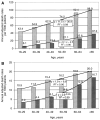Kidney transplantation in the elderly
- PMID: 20006794
- PMCID: PMC2849001
- DOI: 10.1016/j.semnephrol.2009.07.011
Kidney transplantation in the elderly
Abstract
There is an increase in the older incident end-stage renal disease population that is associated with an increasing prevalence of end-stage renal disease in the United States. This trend is paralleled by an increasing rate of kidney transplantation in the elderly. Although patient survival is lower in older versus younger kidney recipients, the elderly benefit from a reduction in mortality rate and improved quality of life with transplantation compared with dialysis. Immunologic, physiologic, and psychosocial factors influence transplant outcomes and should be recognized in the care of the elderly transplant patient. In this review, we discuss transplantation in the elderly patient, particularly the topics of access to transplantation, patient and graft survival, the impact of donor quality on transplant outcomes, immunology and immunosuppression of aging, and ethical considerations in the development of an equitable organ allocation scheme.
Figures




References
-
- Wolfe RA, Ashby VB, Milford EL, Ojo AO, Ettenger RE, Agodoa LY, et al. Comparison of mortality in all patients on dialysis, patients on dialysis awaiting transplantation, and recipients of a first cadaveric transplant. N Engl J Med. 1999;341:1725–30. - PubMed
-
- US Renal Data System. USRDS 2008 annual data report: atlas of end-stage renal disease in the United States. Bethesda, MD: National Institutes of Health, National Institute of Diabetes and Digestive and Kidney Diseases; 2008.
-
- Humar A, Denny R, Matas AJ, Najarian JS. Graft and quality of life outcomes in older recipients of a kidney transplant. Exp Clin Transplant. 2003;1:69–72. - PubMed
-
- Rao PS, Merion RM, Ashby VB, Port FK, Wolfe RA, Kayler LK. Renal transplantation in elderly patients older than 70 years of age: results from the Scientific Registry of Transplant Recipients. Transplantation. 2007;83:1069–74. - PubMed
Publication types
MeSH terms
Grants and funding
LinkOut - more resources
Full Text Sources
Medical

